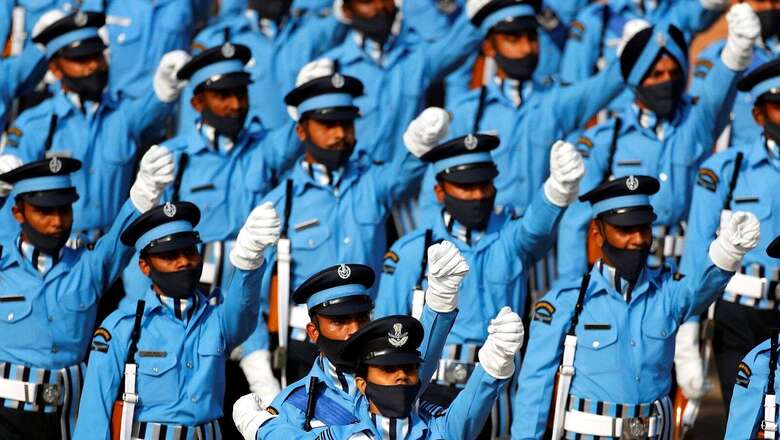
views
In March 2021, the IAF had a shortage of 405 pilots against the authorised strength. As per government data presented in Parliament last year, the number of IAF pilots stood at 3,834 as against the sanctioned strength of 4,239.
For an air force that is rapidly growing and modernising itself with the induction of new platforms, aircraft and weapon systems, this is a major gap.
The new move announced by Air Chief Marshal VR Chaudhari in his Air Force Day address on October 8 in Chandigarh aims at addressing several personnel issues, including plugging this very gap slowly and steadily over a period of time.
That’s not all. The decision also puts focus on the new surface-to-air and surface-to-surface missiles which have been lately added to the IAF’s inventory. In the last few years, the IAF has procured a significant number of Medium Range Surface to Air Missile (MRSAM) and long-range surface-to-air missile (LRSAM) systems.
Stating that this is the first time since Independence that a new operational branch is being created, the Air Chief said IAF personnel in the new branch will man four specialised streams of surface-to-surface and surface-to-air missiles, remotely piloted aircraft (RPA) and weapon system operators in twin and multi-crew aircraft.
He said this will lead to savings of over Rs 3,400 crore due to reduced expenditure on flying training—a notional cumulative figure for the total cadre strength.
How exactly will this move reduce IAF pilots’ shortage?
The issue of shortage of pilots in the IAF has grabbed much spotlight in the recent years. It is to fill this gap that the Air Force Academy at Dundigal, Telangana, admitted the largest number of flight cadets for the flying branch in the current batch at over 160.
What fuelled this further was the standard practice of pulling out operational pilots and posting them to weapons units for three to five years and putting them back to flying units at the end of their tenures.
A top government official told me that this led to a dual loss for the IAF. “Active pilots were out of flying units for three to five years and then when they were back, it took them time to regain their proficiency on the platforms. Once they got back to flying, they would not retain their experience gained in these weapon systems,” the official said.
Stating that the new move is more of cadre management, Group Captain Sivaraman Sajan (Retd), who has commanded a SU- 30 MKI Squadron and held other important appointments, told News18 that until now, specialised roles like WSO (Weapon System Operators) of a twin cockpit fighter, operating RPAs or SAMs were done by officers from Flying Branch.
“Navigation branch officers have been functioning as WSOs of the Su-30 fleet since its inception. However, this was more of a stop-gap arrangement and had many challenges,” he said.
However, with the creation of this new branch, the IAF will no longer have to pull out active pilots from flying units for posting them to weapon systems units. Despite a shortage of pilots, there will be no reduction in the current intake of pilots in the IAF.
“The IAF will make up for the shortfall by not having to divert well-trained, active pilots to weapon systems,” the official quoted above said.
Will create belongingness on weapon systems, enable better HR management
An associated benefit of the move is that it will cultivate and promote a sense of belonging on these weapon systems among officers posted in the new branch.
Most active pilots, IAF officers said, want to get back to flying when posted to weapon systems units. They explained that there thus lacks belongingness on these weapon systems. “This will not be the case with the dedicated branch for weapon systems coming in,” the official explained.
Group Captain Sajan said the creation of a new branch will enable better HR management since all these specialists would be pooled under one branch, and cross utilisation of various streams within the branch is likely to be efficient.
“It would also perhaps improve career prospects and promotion avenues for these officers since certain vacancies are likely to be allotted to the new branch for higher ranks.”
Focus on new weapon systems in IAF
A dedicated branch like this for specialised streams of the IAF has been in the pipeline for some time now.
This garnered much attention after the Balakot air strikes carried out by the IAF in 2019, when India’s SPYDER air defence missile hit a Mi-17 V5 helicopter flying over Srinagar, killing six IAF personnel on board.
The move also brings to focus the IAF’s recent procurements of a range of missiles.
Last year, the Defence Research and Development Organisation (DRDO) handed over the first deliverable Firing Unit (FU) of an MRSAM System to the IAF at Air Force Station, Jaisalmer, Rajasthan. The missile system — designed and developed by the DRDO in partnership with Israel Aerospace Industries (IAI) — is meant to take out fighter aircraft, UAVs, guided and unguided munitions and cruise missiles and can engage multiple targets at ranges up to 70 km.
India also procured the Russian S-400 — a mobile LRSAM — deliveries of which are currently underway and as per schedule. The IAF is also in the process of procuring a range of Unmanned Aerial Vehicles, counter-UAV systems and “weaponising” the existing fleet of UAVs.
Group Captain Sajan said many new systems like RPAs, AWACS, Aerostat radars, BrahMos and twin cockpit fighters like Su-30 have been inducted into IAF in the last few decades.
Stating that it is a “very positive move” on the whole, he said: “Operating these new systems was done through ad hoc arrangements, by pooling in trained personnel, mostly from flying branch. However, now with the formalised structure of a new branch, I expect a more synergised approach by IAF.”
With the objective of streamlined training and inducting personnel directly into surface weapon systems, the IAF clearly stands to benefit from the increased efficiency of having a specially trained force in surface weapons which it aims to build in the years to come.
Read all the Latest News India and Breaking News here

















Comments
0 comment